As an aquarium owner, you must have seen a lot of algae in your tank at some point? That’s because your fish don’t eat it!
In order to prevent the growth of algae, you need to get an algae eater for your tank. But getting a big one can be problematic, so you should go for the best small algae eating fish.
After extensive research, I have compiled a list of the 20 best small algae eating fish. Which I hope will help you to pick the best suitable algae eater for small tank.
But first, let’s address some basic questions.
Note: You might wanna see our other list of best algae eater snails and shrimps.
- 1 What Causes Algae In A Fish Tank?
- 2 Can Fish Food Cause Algae?
- 3 What is Algae Eater Fish?
- 4 Why Do Fish Eat Algae?
- 5 Algae Eaters vs Chemicals
- 6 Do Algae Eating Fish Eat Other Fish?
-
7
20 Best Small Algae Eating Fish
- 7.1 1- Otocinclus Catfish (Otocinclus sp)
- 7.2 2- American Or Florida Flagfish
- 7.3 3- Honey Gourami
- 7.4 4- Gold Spot Dwarf Pleco
- 7.5 5- Blue Neon Dwarf Goby
- 7.6 6- Siamese Algae Eater (Crossocheilus oblongus)
- 7.7 7- Chinese Algae Eater (Gyrinocheilos aymonieri)
- 7.8 8- Hillstream Loach (Sewellia lineolata)
- 7.9 9- Atlantic Blue Tang
- 7.10 10- Convict Tang
- 7.11 11- Tailspot Blenny
- 7.12 12- Twig Catfish (Rineloricaria lanceolate)
- 7.13 13- Whiptail Catfish (Rineloricaria sp)
- 7.14 14- Bristlenose Plecostomus (Ancistrus temminckii)
- 7.15 15- Molly Fish (Poecilia sphenops)
- 7.16 16- Endlers Livebearers
- 7.17 17- African Cichlids (Neolamprologus Multifasciatus)
- 7.18 18- Southern Platyfish
- 7.19 19- Flying fox
- 7.20 20- Rosy Barb
- 8 Which is The Best Algae Eater For Your Tank?
- 9 What Algae Is Bad For Fish?
- 10 Is Red Slime Algae Bad For Fish?
- 11 How To Get Rid Of Red Slime Algae?
- 12 Do Fish Eat Red Algae?
- 13 What Fish Will Eat Hair Algae?
- 14 Why Is My Pleco Not Eating Algae?
- 15 Final Thoughts
What Causes Algae In A Fish Tank?
While most aquarium owners are aware of algae, few really understand the causes. Understanding the causes is vital to controlling it.
The Main Causes of Algae in the fish tank are:
1- Lighting
Having too much light shining into your tank is a common cause of algae growth. This can be caused by excessive lighting or simply having the lights on longer than necessary each day. Most people keep their lights on for far too long each day, and this leads to lots of algae growth and other problems in the fish tank.
2- Overuse oF Carbon
which often goes hand-in-hand with the overuse of medications and other chemicals. Carbon removes organic compounds from the water, but it also removes many minerals that are important for plant health. When these minerals are removed, the plants will slowly die off, leaving more light available for algae growth.
3- Excessive Nutrients
This can be caused by overfeeding, dead spots in your aquarium where food collects before being eaten by fish or invertebrates, decomposing plants or substrate materials, etc.
4- Nitrates
Nitrates are produced when ammonia is broken down by the bacteria that live inside the filter media of your aquarium and break down into nitrites which then turn into nitrates.
If you do not clean your tank regularly enough then these nitrates will accumulate in the water column leading to high levels of algae growth. Another reason why nitrates build-up is because of overfeeding or lack of water flow through your aquarium filter system.
Can Fish Food Cause Algae?
The simple answer is “Yes”. When you feed your fish, they don’t eat all the food right away. Some of it falls to the bottom of the tank where it decays. The remains of this food are broken down by bacteria, which then release ammonia into the water. Which helps algae grow in your fish tank.
Also, the waste products from this decaying process have a high amount of nutrients in them, which become available for algae to grow in your aquarium water. This is why it is important that you remove the leftover food from your tank with a net as soon as you realize that your fish aren’t going to eat it. If you leave uneaten food in the tank, it will just sit there and keep contributing to algae growth.
What is Algae Eater Fish?
Algae eaters are fish (or snails) that help to maintain the ecological balance in a fish tank. If you think of your aquarium as a small ecosystem, algae eaters are essential to keeping it healthy and clean. Their job is to eat algae, which is a plant that grows naturally in tanks. Algae can grow out of control if it’s not kept in check, which can make the water unsafe for other fish and cause damage to the tank itself.
Algae eaters are usually bottom feeders; they swim around the bottom of the tank looking for things to eat. They are very effective at cleaning up debris from plants, leftover food, and other waste from the tank.
Why Do Fish Eat Algae?
If your aquarium has some algae growing on the glass, then you might have witnessed your fish eating it. It may seem strange to you that a fish would eat something as unappetizing as algae, but it’s actually quite common for fish to do so.
Most types of algae are harmless and even beneficial for fish because they provide them with some nourishment.
The fish that do this are called “herbivores” meaning they eat plants. In the ocean, there are fish that are called herbivores, but these are not the same as freshwater herbivores. Oceanic herbivores eat things like seaweed and kelp, which are much more nutrient-rich than the algae that grows in an aquarium tank.
Algae Eaters vs Chemicals
In my opinion, Algae Eating Fish is the best option to remove algae from your fish tank but at the same time, you might want to look into the algae killing chemicals that are available to buy. There are many of them and they can be found in most pet stores or online.
The one that I would recommend is called “Jungle TB620W“. This product was designed to kill algae and it does a great job at doing it. I have used it in my aquariums several times and each time it has done what it was designed to do.
It works by killing the algae cells and causing them to die and fall off of your tank walls and decorations. After doing this for about a week you should be able to see a big difference in your aquarium. This will make it much easier for your fish to clean up the rest of the tank because there will be less algae for them to eat.
When using chemicals you will want to make sure that you follow all of the directions on the bottle very carefully so that you don’t accidentally poison your fish.
Do Algae Eating Fish Eat Other Fish?
Yes, Algae eating fish have a bad reputation for behaving aggressively towards other fish. But the truth is that it depends on the type of algae eating fish you are having in your aquarium.
There are many types of algae eating fish and some of them are really peaceful. Which we are going to discuss later in this article. But still, you need to be careful when choosing algae eating fish for your aquarium.
Tip: If you have any doubt then consult with an expert before buying anything for your aquarium.
20 Best Small Algae Eating Fish
Here is the list of the best small algae eating fish for your aquarium. Browse through it and pick the most suitable one for yourself!
1- Otocinclus Catfish (Otocinclus sp)
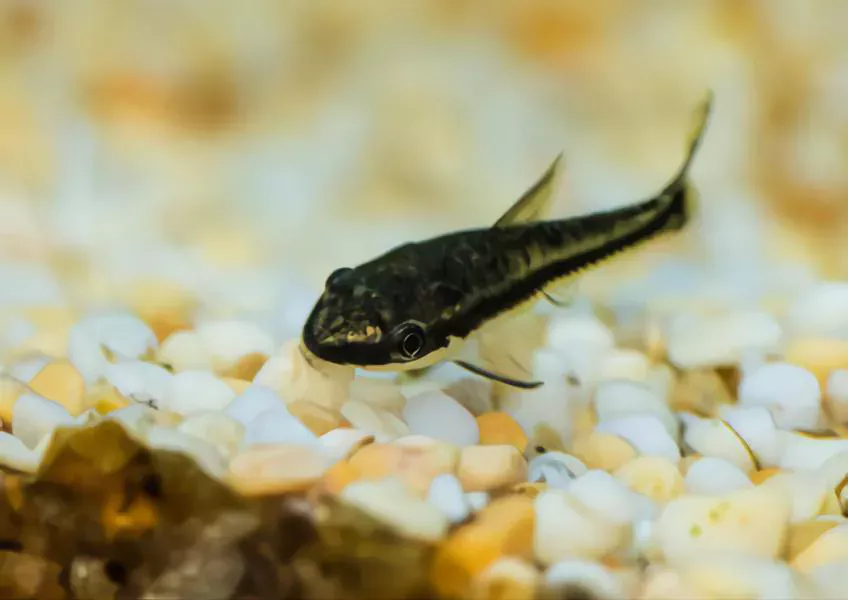
Otocinclus Catfish is one of the smaller varieties of Catfish. It is one of the smallest algae eater fish for small tank. They are known for eating black beard algae, a type of algae that few fish can eat.
Otocinclus Catfish can grow up to 2 inches when fully grown. The Otocinclus Catfish loves to graze on algae and biofilm that grows over driftwood and other decorations in the fish tank. Otocinclus Catfish prefer to stay in groups so they should be kept in groups of at least 5 or 6.
Algae eater Otocinclus Catfish is a great addition to any community fish tank that needs some help with algae control. They are very social and like to have companionship so they should be kept in groups.
2- American Or Florida Flagfish
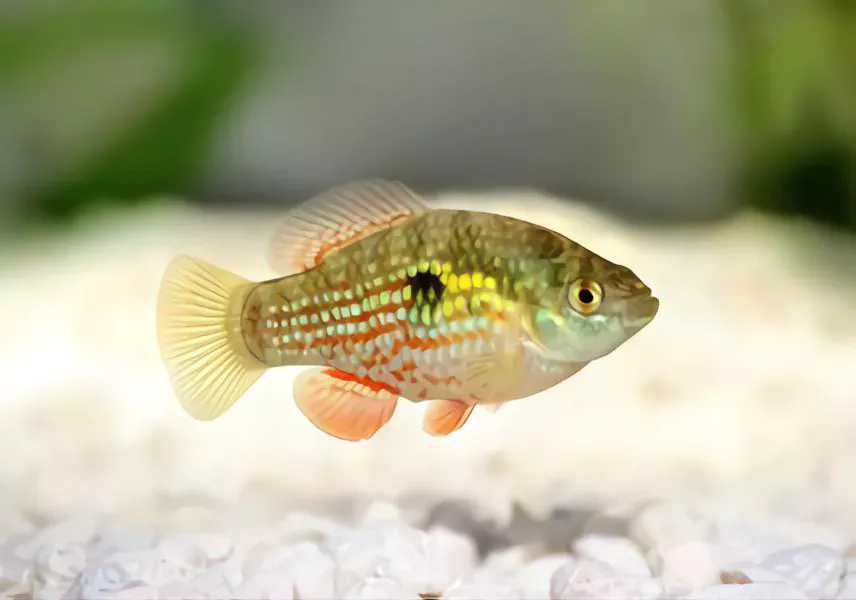
Flagfish are great algae eaters, but they also like to eat plants. To keep aquarium plants thriving, you need to feed the flagfish small amounts of algae wafers or spirulina tabs instead.
Their name comes from their unique coloration, which resembles the American flag. The body is covered with alternating bands of blue and orange that are laterally compressed to give them a thin, elongated shape.
I recommend Keeping the aquarium water at a pH level between 7 and 7.5, and ensuring that the water temperature ranges from 72°F to 84°F (22–29 °C). And make sure not to overcrowd the tank with other fish. For every inch of American Flagfish, you should have about 5 gallons (19 liters) of water in your tank.
3- Honey Gourami
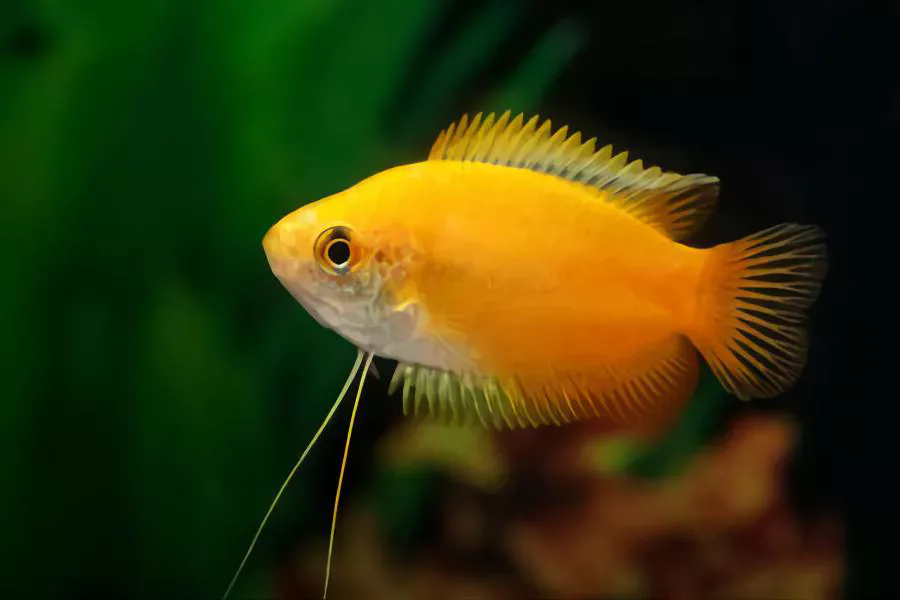
Honey Gourami is a freshwater fish that is suitable for the community tank. This peaceful fish is also a great algae eater.
The Honey Gourami is a very unique and special species. It is a very peaceful fish, so it can be kept with other similar species in a community tank, but it would be best to keep it alone if possible. If a male Honey Gourami is placed in with another male, the two will fight until one of the males dies. The female Honey Gourami is less aggressive than the male and can be kept in a group with several other females or as part of a small community of peaceful fish.
Honey gouramis are smaller than most other gouramis and are also more reclusive than others. They will often hide away in plants to avoid being seen too often by their owners or other fish in the aquarium.
Honey Gourami do not grow longer than 3 inches or 8 centimeters. Even though they are smaller than other gouramis, they still require a decent-sized tank to call their own. They have small mouths and eat small food like worms, crustaceans, and insects (smaller than their mouth).
4- Gold Spot Dwarf Pleco
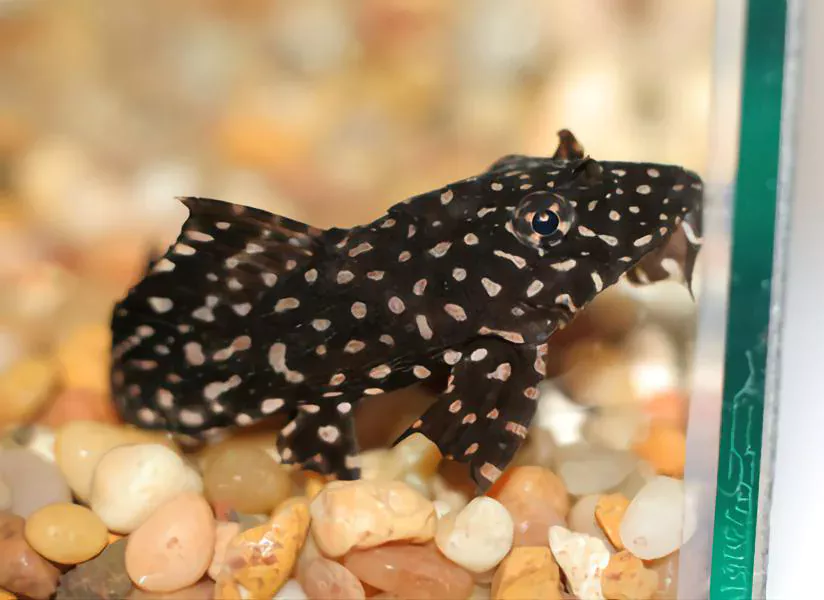
Algae eaters are a wonderful addition to a freshwater fish tank. They help keep the water clean, and they look pretty cool too. One of my favorite algae eaters is the Gold Spot Dwarf Pleco.
If you’re thinking about adding one to your aquarium, there are a few things that might help you decide.
Gold Spot Dwarf Plecos are native to South America, where they can be found in parts of the Amazon River Basin.
Unlike most other Plecos, the Gold Spot Dwarf Pleco will only grow to around 2 or 3 inches long at maturity. This makes them ideal for smaller fish tanks (30-40 gallons or less).
Like other Plecos, they feed primarily on algae, but it’s important to supplement their diet with high-quality flakes and pellets as well.
These fish tend to be fairly peaceful, but can be territorial when breeding. For this reason, it’s best to keep them in small groups of two or three unless you have a very large aquarium (55 gallons or larger).
5- Blue Neon Dwarf Goby
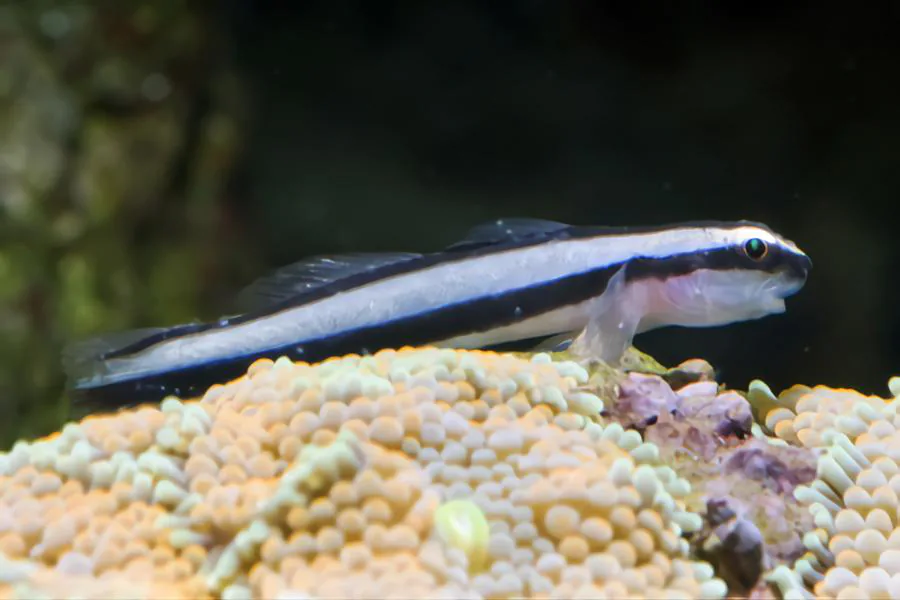
Blue Neon Dwarf Goby is also a perfect small algae eating fish, growing only to 2 inches. It is a peaceful fish that you can keep in a community aquarium. It is easy to care for and suitable for beginners. If it is not kept with other fish that are too large or aggressive, it will live happily for many years. Its diet consists of both meaty food and vegetables.
Blue Neon Dwarf Goby’s maximum size is 2 inches (5 cm). It has an elongated body with a flat underside. The body color is grey with bluish stripes along the sides. There are blue spots on the head and fins. Males have more intense colors than females, but there is no way to distinguish between the sexes except by observing their behavior during spawning.
6- Siamese Algae Eater (Crossocheilus oblongus)
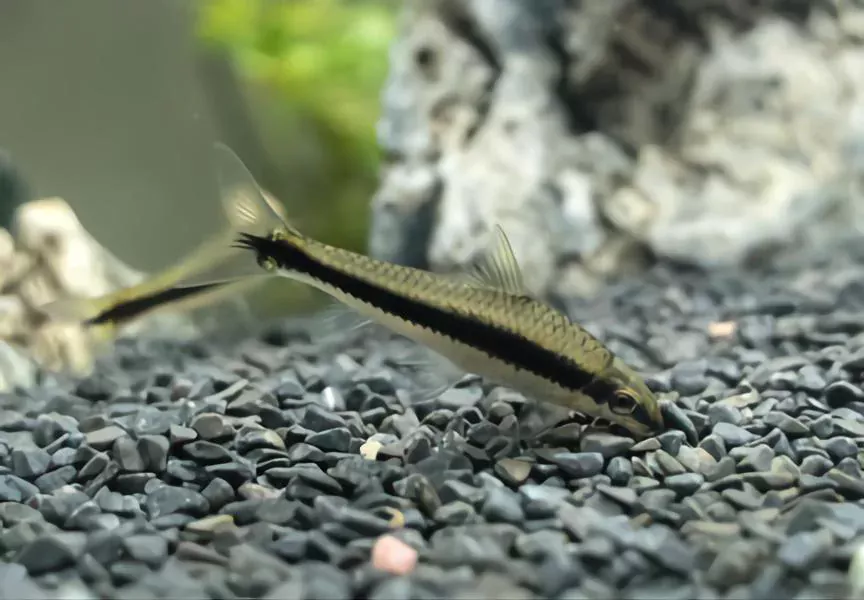
The Siamese Algae Eater is a perfect algae eater for most fish tanks. These fish are small and very peaceful. They will eat brown, black, blue-green, and red algae. They can also be used to clean up leftover food in the tank.
These fish will grow up to about 6 inches long and generally live about 10-12 years. They are known as hardy fish, but I have had some die from stress due to water changes not being done properly or when I haven’t been able to catch all of them during a water change to put them in the bucket with their dirty water.
Here are a few facts about Blue Siamese Algae Eaters:
- They can jump out of the tank so make sure your tank is covered.
- They like to be in groups of 5 or more so make sure you get enough to keep each other company.
- You will need at least a 20 gallon tank for 5 of these if you want to house a school of them.
- Blue Siamese Algae Eaters do well in brackish and freshwater tanks.
7- Chinese Algae Eater (Gyrinocheilos aymonieri)
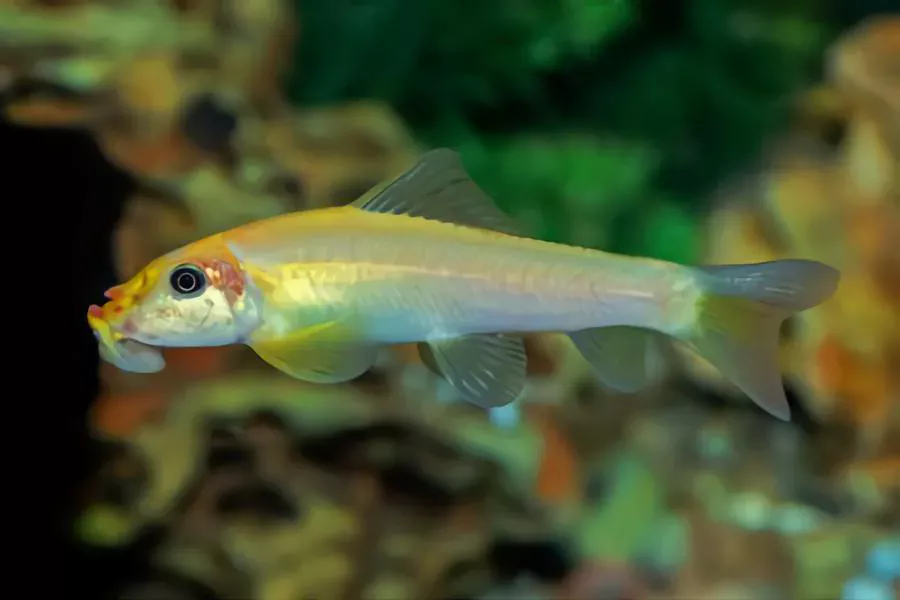
The Chinese Algae Eater is an awesome algae eater for fish tanks. They are also known as the Honeysucker, and the scientific name is Gyrinocheilos aymonieri.
Chinese Algae Eaters are schooling fish and should be kept in groups of five or more. They do well with other active fish but can become belligerent when kept with slow-moving fish. They may attack other bottom-feeders, such as loaches and cory catfish, and will eat small fish and invertebrates.
Chinese Algae Eaters have a habit of sucking on the sides of tankmates. This behavior starts at a young age, and as the Chinese Algae Eater grows larger, it can damage the scales and remove the protective slime coating from other fish.
8- Hillstream Loach (Sewellia lineolata)
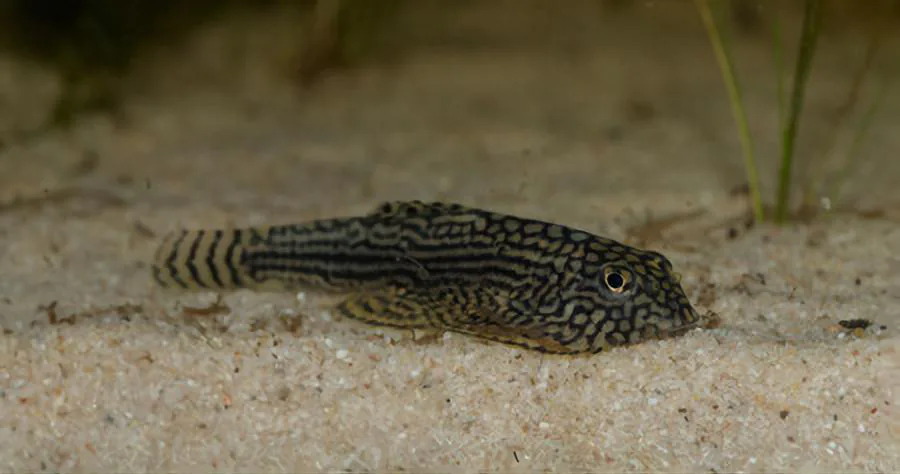
Hillstream Loach (Sewellia lineolata) is an excellent algae eater for fish tanks. It’s a bottom-dwelling fish that has a sucker-like mouth. These loaches are different from the other loaches due to their preference for fast-moving, oxygen-rich water. They are commonly found attached to rocks near the surface of fast-moving streams in Asia, where they eat algae and detritus.
They do best in tanks with lots of rocks, caves, driftwood, and fine sand or gravel substrate. Because they come from fast-moving waters, they must have good circulation and high oxygen levels in the water. If you can provide a current that makes it difficult for them to stay on the bottom of the tank, even better!
The Hillstream Loach comes from fast-flowing areas and needs strong water currents as well as high levels of dissolved oxygen and carbon dioxide (CO2). Good filtration is therefore essential. They will also thrive in slightly cooler water than many tropical fish species are used to, so an air conditioning unit may be beneficial too
Some aquarists believe Hillstream Loaches will die if kept in temperatures above 25°C/77°F but others keep them successfully between 25-28°C/77-82°
9- Atlantic Blue Tang
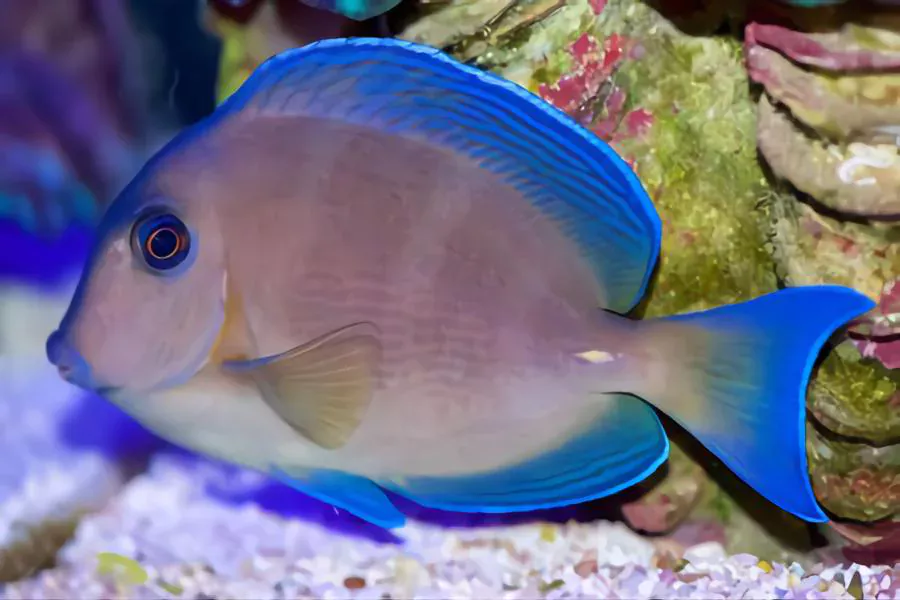
Atlantic Blue Tangs are great for a large fish tank. They are popular saltwater fish that hails from the Indian Ocean, Red Sea, and the Pacific Ocean. Atlantic blue tangs have an oval-shaped body with a bright blue tail.
Most Atlantic Blue Tangs grow to about 8 inches long. Their lifespan is about 10 years long. Atlantic Blue Tangs can be aggressive towards other fish in the tank, so it is recommended that you keep one of these fish with larger more aggressive fish that will not be intimidated by the Atlantic Blue Tang’s behavior.
Atlantic Blue Tangs eat algae, which is why they are used as a cleaner for overgrown tanks. If they live alone in a tank they won’t need much food as they will eat most of the algae in the tank naturally. If you want to help out your Atlantic Blue Tang, give them seaweed if they don’t have many plants in their tank to feed off of, or if you want to offer them some variety in their diet.
10- Convict Tang

When it comes to aquariums, there are many different types of fish and species out there But I have always been a huge fan of the Convict Tang algae eaters for fish tanks.
Convict tangs are extremely hardy and are a great addition to any tank. They do very well with other fish, they get along great with other convict tangs, and they can also be kept in large schools.
They grow to be up to eight inches long, but they also stay relatively small. They usually only grow to be about six inches long in tanks.
They like to eat a variety of things including frozen foods, veggie flakes, and dried spirulina flakes. This makes them super easy to feed and it helps keep your tank clean.
If you are looking for a good algae eater for your tank, then the convict tang is definitely one that you should consider adding to your tank!
11- Tailspot Blenny
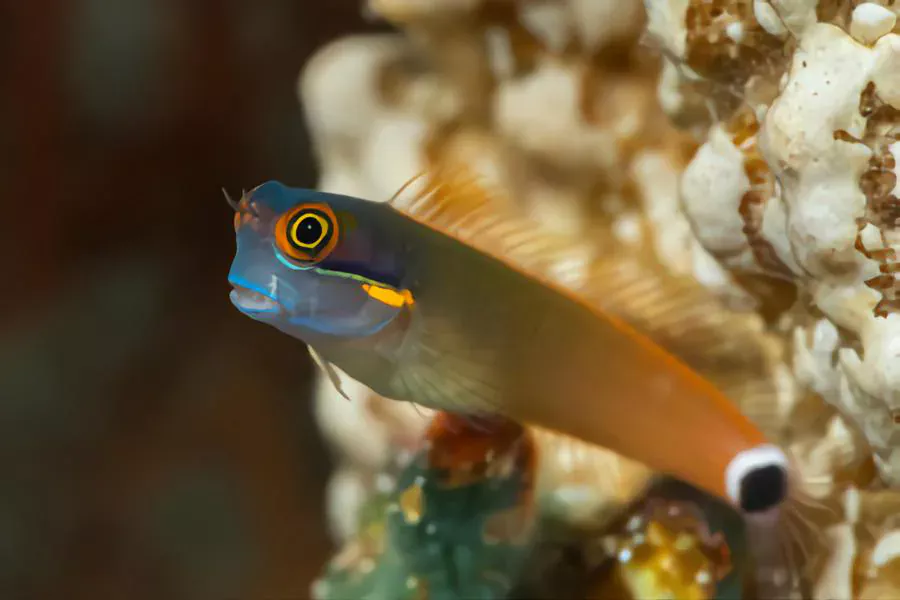
This little guy is a great algae eater, but he also has such an awesome personality. I have had these guys from both Hawaii and Indonesia, and they are definitely my favorite fish.
One of their best features is that they are small. They usually get to be around 4 inches long, which is perfect for any size tank. They are very active and make the perfect tank mate for almost anything.
I have had them in tanks with everything from little clownfish to large triggers. They seem to get along with all of the fish that I have seen them with so far. Another great thing about these guys is that they don’t eat any corals or live rock! I have had mine for months now without worrying about my corals at all.
My only caution would be to make sure that your Tailspot Blenny has enough places to hide if you put him in with something like a Moorish Idol or a Tang. These larger fish can be bullies at times, so it is best to give your new Blenny a chance to adjust to his new surroundings before leaving him alone with larger fish.
12- Twig Catfish (Rineloricaria lanceolate)
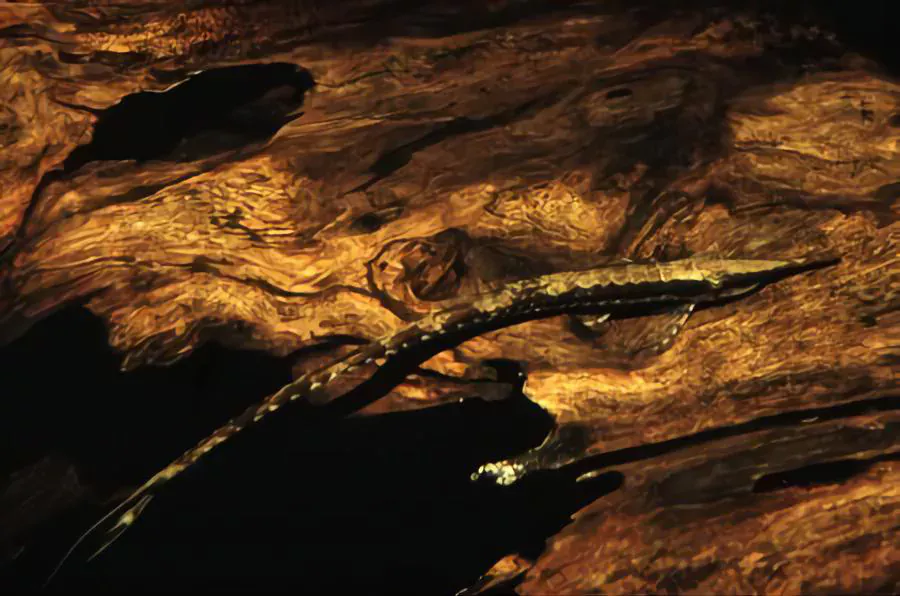
The Twig Catfish is a peaceful, nocturnal scavenger that will eat most foods but prefers algae wafers and other vegetable matter.
Other species of Rineloricaria catfish are also referred to as “Twig Catfishes” in the aquarium hobby; however, these other species are more common in the hobby than Rineloricaria lanceolata.
These fish are primarily bottom dwellers and should be kept with other peaceful tankmates.
A minimum of 30 gallon tank is required for this fish to be kept alone, although they do best in larger tanks with some driftwood and vegetation.
These fish prefer water with high oxygen content and it should be filtered through peat.
13- Whiptail Catfish (Rineloricaria sp)
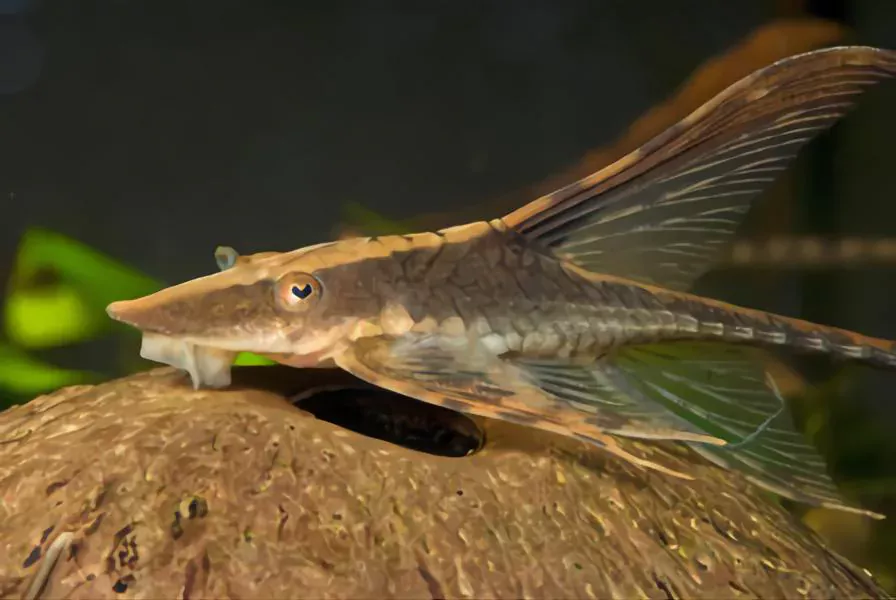
Whiptail Catfish is a good choice if you are looking for an algae eater. It is a nocturnal scavenger and is a very common fish in the fish-keeping hobby. Perhaps one of the most popular in the Loricariidae family.
This peaceful catfish is a great addition to any community freshwater aquarium. It is best kept with other peaceful community fish such as tetras, danios, rasboras, and gouramies.
They are usually not aggressive but can be territorial and sometimes may eat small fish that venture into their cave. The Whiptail Catfish should always be kept in groups of 3 or more so they do not get stressed out by being alone.
These fish are omnivores and will eat both meaty foods and plant matter, therefore having a varied diet is important to keep them healthy and happy.
14- Bristlenose Plecostomus (Ancistrus temminckii)
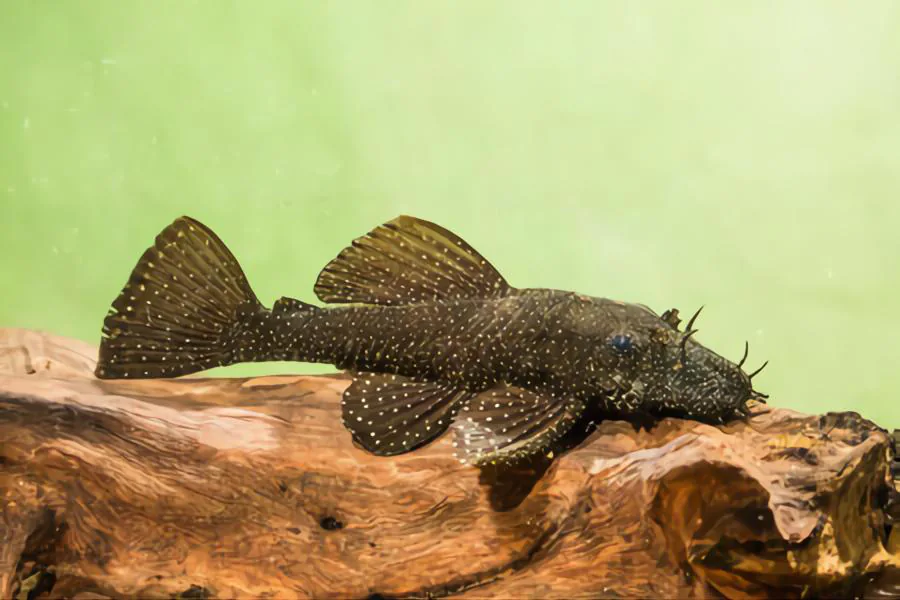
The Bristlenose plecos are a smaller variety of the common pleco and come in several different varieties which have different color patterns. They are easy to take care of, and only require 20 gallon tank. They also make excellent algae eaters for your fish tank.
The Bristlenose Plecostomus is a peaceful fish that can be kept with other similarly sized non-aggressive fish. The Bristlenose Plecostomus is an omnivore and will eat all types of algae in your fish tank. They are nocturnal so you may not see them much during the day, but don’t worry they will be up at night keeping your tank clean by eating all the algae.
When you first get your Bristlenose Plecostomus they may seem shy and want to hide a lot, but once they become comfortable in their new home they will start coming out more often and feeling more confident. You can even breed Bristlenose Plecos if you wish to add more to your tank or sell them for extra income.
15- Molly Fish (Poecilia sphenops)
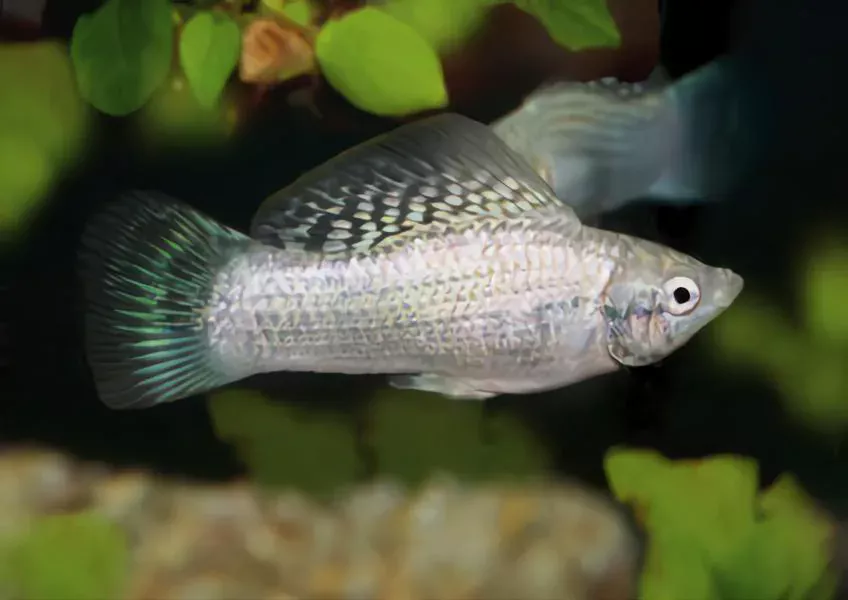
Mollies are very popular small algae eating fish due to their easy care level, ability to adapt to different water conditions, and great personality. Mollies are peaceful schooling fish that are great for the beginner aquarist and seasoned aquarist alike. They can be kept in a freshwater community aquarium with other peaceful fish or other mollies. Mollies can also be kept in brackish aquariums.
Molly fish are livebearers so they will give birth to live young rather than lay eggs. This makes them easy to breed since you don’t have to worry about finding their eggs and moving them to a separate fry tank. There are many different varieties of molly types available today including Sailfin Molly, Dalmation Molly, Lyretail Molly, and Black Molly. They come in a variety of colors including black, white, yellow, orange, red, silver, and combinations of these colors.
16- Endlers Livebearers
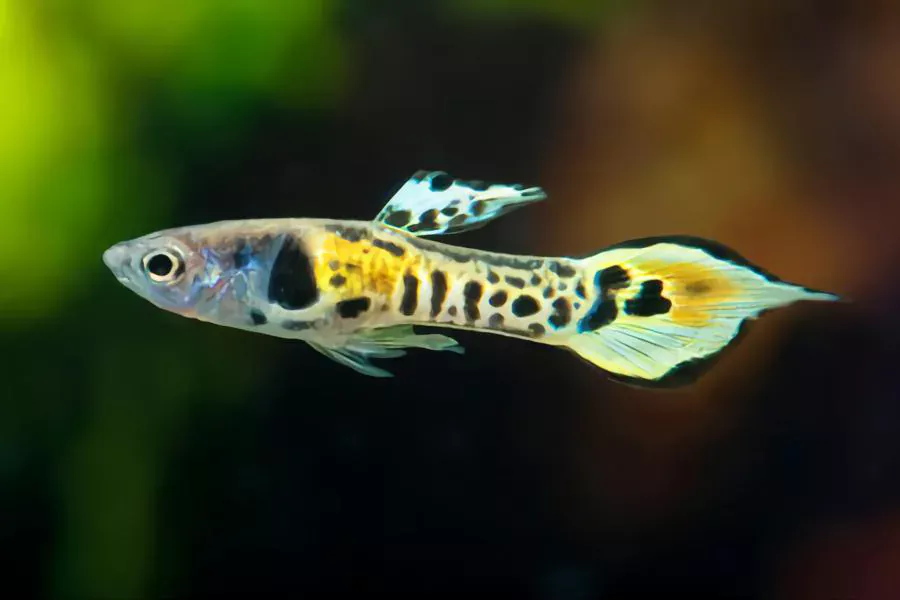
Endlers Livebearers are very colorful small algae eating fish that were first discovered in Venezuela. They have been bred for their colors and patterns over many years by hobbyists.
There are several varieties of Endler Livebearers, including solid color varieties such as black bars, blue bars, yellow bars, and orange bars. However, the most popular type of Endler is the mosaic variety which can come in a wide range of colors and patterns.
They’re very peaceful fish, so you can keep them in a community tank with other peaceful species. Some people enjoy mixing them with various types of Tetras for beautiful color combinations. They’re also nice companions for live-bearing Snails such as Nerite Snails or Mystery Snails.
Endlers livebearers grow to about one inch long. Males have colorful tails, while females have shorter, less colorful tails and larger bodies. Although, Although They are algae eaters, but also need some meatier foods like brine shrimp and bloodworms.
17- African Cichlids (Neolamprologus Multifasciatus)
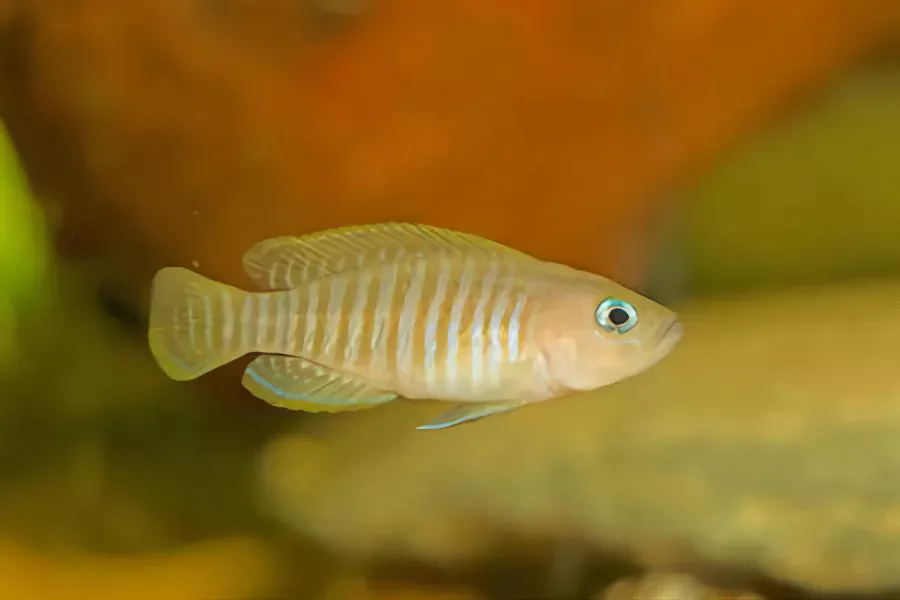
African Cichlids (Neolamprologus Multifasciatus) are small algae eaters that should be kept in a group of six or more. They are best kept with other peaceful fish and may not be well suited for a community tank.
African Cichlids (Neolamprologus Multifasciatus) are perfect for planted tanks, especially if you have a lot of small plants like java moss, java fern, and other small fast-growing plants. They will mow them down in no time! They are semi-aggressive eaters too so they won’t have any problems getting their fair share of food during feeding times.
18- Southern Platyfish
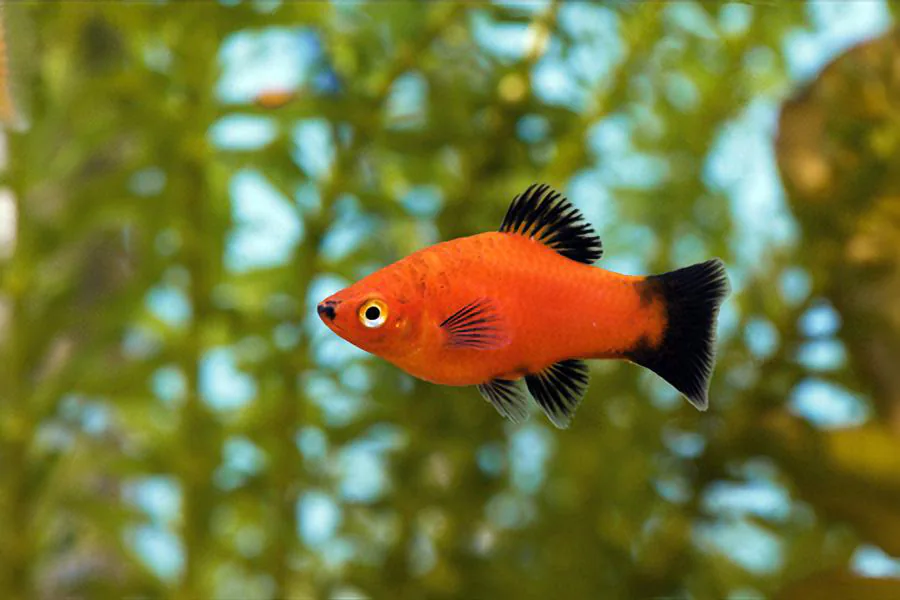
Southern Platyfish or Micropoecilia picta is a livebearing fish that is sometimes also referred to as platy. It is a popular small algae eating fish that originates in the freshwater streams of South America. It looks very similar to Molly fish.
The Southern Platyfish is a very peaceful and beautiful fish that makes for an interesting addition to any aquarium. It grows to about 2 inches in length and has a lifespan of about 3 years.
Because it is such an active swimmer and needs plenty of space, a large tank is required for keeping them (at least 10 gallons). They are not picky eaters, so feeding them should not be an issue.
Southern Platyfish prefer living in schools, so it is best to keep at least 6 of them together. They can be kept with most other species of fish, but those that are aggressive should be avoided.
19- Flying fox
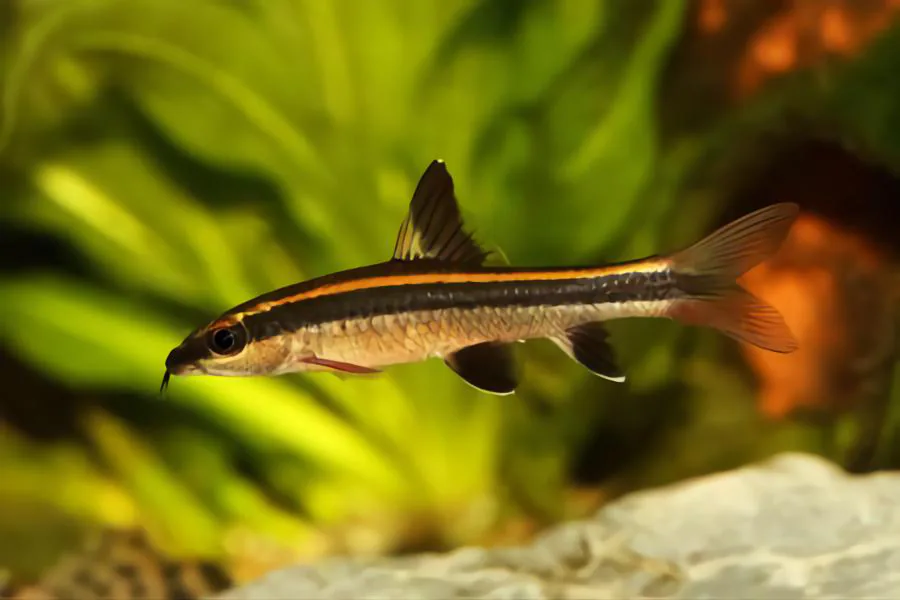
Flying Foxes are omnivores, which makes them one of the best algae eating fish to keep in your tank. These omnivores will eat algae as well as plant matter and small insects too.
You need to give them veggies in their diet or they will start to nibble at live plants. They also need some protein in their diet, so include flakes or pellets into their diet from time to time too.
Algae eater flying fox has a yellowish-brown color on his body, with two black stripes on his back. The first stripe runs from above his eyes to his tail fin and the second stripe starts behind his gill plate and ends at the base of his tail fin.
They can grow up to 6 inches long and have a life span of around 8 years when kept in captivity (which means your aquarium).
20- Rosy Barb
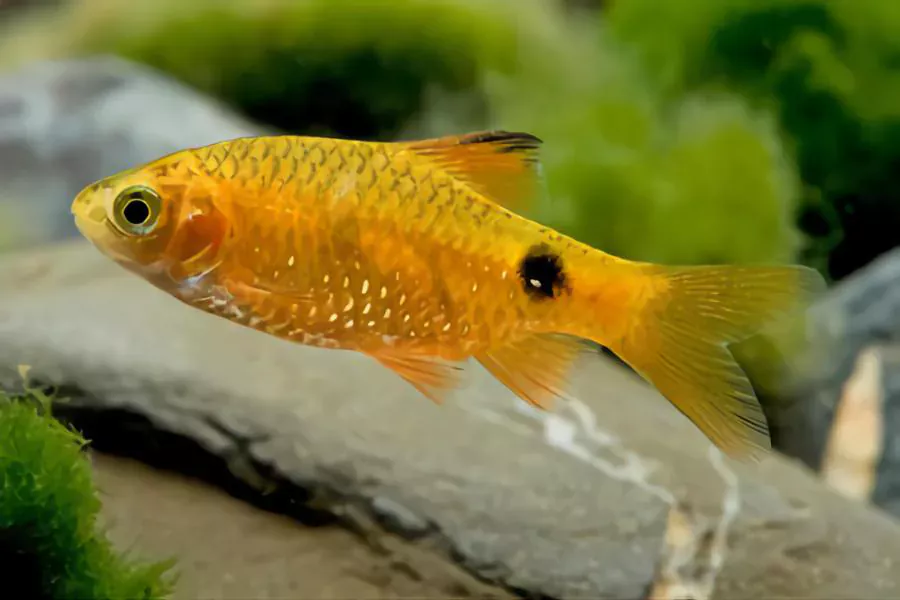
The Rosy Barb is a very popular small algae eating fish. This is probably because it is a very hardy fish, and also beautiful. It can be kept by almost all aquarists, even beginners, as long as they can offer the correct conditions
The Rosy Barb (Barbus conchonius) is native to India and Pakistan. In the wild, it can reach up to 12 cm in length, but in aquariums, it only gets to about 8 cm long.
It is not a picky eater and it accepts most foods, from flakes to live food, worms, and other treats. These fish are very peaceful and they are an excellent addition to a community aquarium.
Which is The Best Algae Eater For Your Tank?

If you take my opinion, Siamese Algae Eater is the best small algae eating fish. It is known to eat black beard algae, brown diatom, and soft green algae but not hair or red slime algae.
Please keep in mind, There are two types of Siamese Algae Eater (SAE). The first one is the True SAE and the second one is the False SAE.
The main difference between true and false SAE is that only true SAE will eat black beard algae (BBA) and black brush algae, while false SAE will not.
With Siamese Algae Eater, you don’t need any other algae eating fish. This fish will take care of all the algae problems in your tank.
What Algae Is Bad For Fish?
Brown algae and some blue-green algae, particularly Anabaena and Microcystis are considered bad for fish because they can produce toxins harmful to aquatic life.
These types of algae can grow over your tank, covering it with an unpleasant slime. Some people have reported problems with diatom algae, which looks like fine sand on the glass and substrate of their tank.
How do you know if there is too much algae in your fish tank? If you see a significant amount of green or brown algae growth in your tank, or if you find that you’re having to clean your tank every day, you may have a problem with too much algae growth.
Some types of algae are considered harmless because they don’t cause any problems for the fish in your tank; however, they can be unsightly and even difficult to remove from the glass. If this is the case, it’s best to try to get rid of them before they get out of control.
Is Red Slime Algae Bad For Fish?
Generally, red slime algae is not bad for fish. It is caused by cyanobacteria, which is actually a bacteria, not algae. It can appear as a reddish slime or film on rocks and substrate, a fluffy red coating on plants and decorations, or as a slimy growth covering the entire tank.
Although it is not hazardous to any living creature in your tank if left out of control, it can completely cover your aquarium plants and live rocks which look terrible. It can also disturb your bacterial balance and cause instability in your aquarium.
How To Get Rid Of Red Slime Algae?
Cyanobacteria do not require light to grow, so they will grow whether your aquarium has lights or not. It can occur in any type of tank with any lighting setup. However, it tends to flourish when only blue spectrum bulbs are used, such as GroLux and Super Daylight bulbs.
Do Fish Eat Red Algae?
Yes, they do. Fish can eat red algae in your aquarium by scraping it off surfaces using their teeth and eating it. Some fish are better at doing this than others and some fish will eat red algae better than green algae or brown algae.
A good example of such a fish is the Sailfin Tang ( Zebrasoma veliferum ), which we discussed earlier. This fish has teeth that are made for scraping algae from hard surfaces and eating it.
What Fish Will Eat Hair Algae?
Here is a list of fish that eat hair algae. I have compiled this list by researching each species listed in several books and online resources. Please keep in mind, Not every fish will behave the same way in every aquarium, but this is will give you enough knowledge to select the best one when you are trying to decide what species to add:
- Siamese Algae Eater
- Tangs (e.g. Convict Tang)
- Rabbitfish
- Molly Fish
- Blue Neon Dwarf Goby
Why Is My Pleco Not Eating Algae?
It is a common misconception that algae eating fish will eat all of the algae in your tank. Algae-eating fish are not always a “fix” for algae problems. In fact, some fish such as the Chinese algae eater (Gyrinocheilus aymonieri) can be more trouble than they are worth! Some fish that eat algae will only eat certain types of algae, and some will just not touch it at all. So don’t expect too much from your pleco.
Final Thoughts
If you’ve got an algae problem, and algae eaters don’t work for you, try using medication to get rid of algae from fish tanks.
Aquarium “scrubbers” are the most effective way to kill a wide range of green algae, but if your tank’s inhabitants will tolerate it, a chemical solution can also do the trick.
But always keep in mind, The best way to get rid of algae in a fish tank is to clean the aquarium, get rid of the food source, and starve it out. Algae usually occur when there is an abundance of nutrients available for it to grow. You can also starve it out by turning off the lights or using an algaecide to kill it. Please let us know in the comment which one of these methods worked for you.

